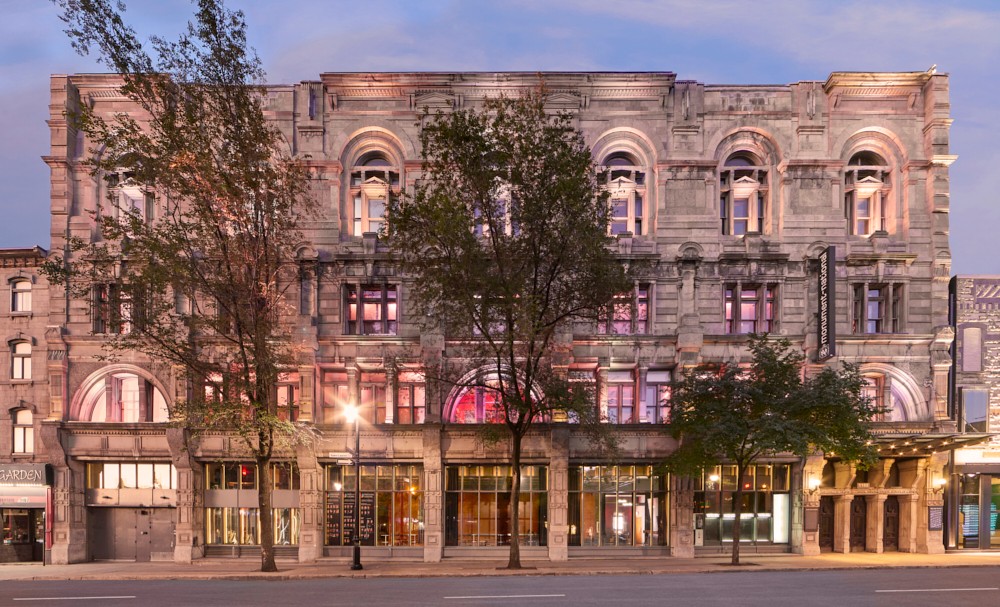The Monument-National before 1893
Today, the Monument-National is the oldest continuously operation theatre in Quebec, if not Canada. Belonging to the National Theatre School since 1971, centre of Yiddish theatre between the two world wars and host to the famous Eden Museum at the turn of the century, the Monument-National has seen a lot of history since it opened in 1893. But, like Rome, it wasn't built in a day, and its history goes back much further than its opening. To really understand the spirit of the Monument, we need to go back in time. Not just to 1891, when work began, but even further back. Dive into this article to find out the origin story of the Monument-National; the prequel to the story you may already know.
As with any subject related to French-Canadian culture, we could go back to Jacques Cartier's arrival in 1532, or the founding of Quebec City in 1608, or even the Durham Report of 1839, which said that French-Canadians were a people "without literature and without history", immediately provoking the writing of our history and literature. However, for the history of the Monument-National, we can jump back only to 1834, when journalist Ludger Duvernay founded what became the Association Saint-Jean Baptise. The aim of this association was to protect, enhance and encourage the development of the French-Canadian nation.
The idea for the Monument-National came to Duvernay in the offices of the Association Saint-Jean Baptiste nearly 50 years later. Well, it wasn't actually the same Ludger Duvernay, but rather his son Ludger-Denis, and to be exact, it wasn't the Association's offices, but the home of the president of its executive committee. The Association Saint-Jean Baptiste had no offices, and the very first mention of a building or hall for their use was intended to remedy this situation. As early as 1883, the ASJB formed a Comité de la Salle Saint-Jean Baptiste, soon renamed the Comité de l’Édifice or simply the comitte for the building. The project quickly evolved and grew in scale: not just an office space, the building would be a "true community centre for all French-speaking Montrealers"[1], where the ASJB could head up all manner of French-Canadian cultural and professional organizations. The project soon included the association's offices, a library and a multitude of rooms for various organizations, and eventually even for storefronts.
A plot of land was purchased in the town centre and the foundation stone laid on June 25, 1884. This symbolic first stone was also likely to be the last, as the project rapidly stalled. Political and economic crises followed one another, and the Association struggled to raise the funds needed for such a large-scale project. It wasn't until 1890 that funds began to flow in again, largely thanks to two measures. Firstly, the Association stopped selling $500 bonds (the annual salary of a worker at the time) and instead sold $10 shares. As a result, many more people were able to contribute. Next, the Association launches a lottery to raise even more funds. Success was immediate, and the Monument-National project was back on track.
However, the city had changed since 1884, and the Monument site was no longer in the heart of Montreal. The Association Saint-Jean Baptiste sold their land (foundation stone and all) and bought the current site on Saint-Laurent Street for $44,000 (The price to rent a downtown parking space today). With this move came a new project: Boulevard de l'Opéra, renamed Boulevard National in 1899. This project would have seen the construction of an opera house on rue Saint-Denis and a grand boulevard leading to the Monument-National.
However, despite the Association's new funding practices, construction of the Monument drained the coffers and stalled almost immediately. Work began in April 1891 and was scheduled for completion in June 1892, but the work was nowhere near done by that date. The official inauguration was then scheduled for June 25, 1893, but work dragged on. In March 1893, ASJB president Laurent-Olivier David "armed himself with a pencil and diligently crossed out everything he didn't consider essential for the immediate future: the elevators, the vast marble staircase at the main entrance, the statues, the logettes, the cornice, the electronic installation, the heating and ventilation system, the interior finishing, the doors to the meeting rooms, the entrances and the stage in the main hall"[2]. The inauguration would take place on June 25 as planned, no excuses! We see that the Association Saint-Jean Baptiste is like the rest of us: big plans on payday, but once the end of the month arrives, we often barely cover the bases.
And so our National Monument is born. It's unfinished, the premises aren't leased and the Association Saint Jean Baptiste is $200,000 in debt (about $7.1 million in 2023). Built for the glory of the French-Canadian nation, the Monument can't afford to turn its back on English speakers: the first artistic show to be staged at the Monument was an adaptation of Shakespeare's Midsummer Night's Dream...in English.
The Monument had quite a history even before it opened to the public, long before the years of Frivolin and the National Theatre School. From its earliest days to the present day, the history of the Monument-National has been a series of changes of direction and adaptations to new realities.
Sources:
Jean-Marc Larrue, Le Monument Inattendu, Le Monument National 1893-1993
La Presse
École Nationale du Théâtre
Société Saint-Jean Baptiste
Annuaire des désignations patrimoniales fédérales
[1] Jean-Marc Larrue, Le Monument inattendu, Le Monument National 1893-1993, LaSalle,Hurtubise HMH, 1993, page 36.
[2] Jean-Marc Larrue, Le Monument inattendu, Le Monument National 1893-1993, LaSalle,Hurtubise HMH, 1993, page 67

Figure 1: La Presse May 26, 1894


Figure 5: La Presse June 25, 1893


Figure 3: La Presse May 31st, 1894



Comments